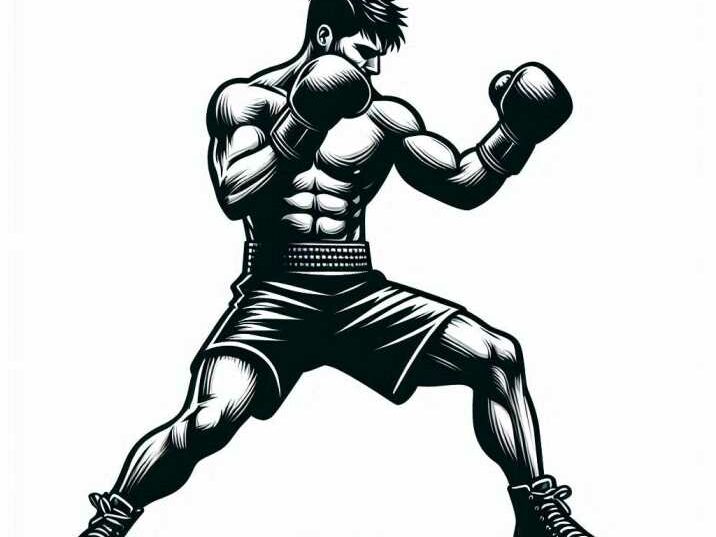Introduction
Table of Contents
The stance is the cornerstone of any martial art, dictating how fighters move, defend, and launch attacks. For enthusiasts and practitioners of Muay Thai and Boxing, understanding the differences between their respective stances is crucial. This blog post delves into the intricacies of the Muay Thai stance vs Boxing stance, offering a comprehensive comparison that will enhance your knowledge and improve your training. By the end of this article, you’ll have a clear understanding of how each stance influences fighting style and strategy.
Key Characteristics of Muay Thai and Boxing Stances
Muay Thai Stance

Foot Position
In Muay Thai, the feet are typically positioned shoulder-width apart, providing a solid and balanced foundation. The lead foot is slightly pointed outward, which helps in maintaining stability while allowing for quick movements and powerful kicks. This stance ensures that the fighter can pivot easily and shift weight effectively, crucial for executing various techniques.
Weight Distribution
Weight distribution in the Muay Thai stance is either even or slightly more on the back foot. This positioning is essential for delivering quick and powerful kicks and knee strikes. By keeping more weight on the back foot, fighters can lift the lead leg effortlessly for kicks, checks, and teeps (push kicks). It also helps in maintaining balance when absorbing or deflecting incoming strikes.
Guard Position
The guard position in Muay Thai is characterized by high hands and tucked elbows. This high guard protects the head from punches while the elbows shield the ribs from body shots. The lead hand is slightly forward, ready to jab or parry, while the rear hand stays close to the chin, prepared to deliver powerful hooks or uppercuts. This guard is crucial for both offense and defense, allowing fighters to block and counter quickly.
Knees and Elbows
Knees in the Muay Thai stance are slightly bent, providing a spring-like effect for quick movements and powerful strikes. Bent knees also help in absorbing impact and maintaining balance. Elbows are positioned to block incoming strikes or to deliver sharp elbow attacks. The bent knees and positioned elbows make it easier to transition between offensive and defensive maneuvers, a hallmark of Muay Thai’s dynamic fighting style.
Boxing Stance

Foot Position
In Boxing, the feet are also shoulder-width apart, but the lead foot points forward while the rear foot is angled slightly outward. This stance facilitates quick, linear movements essential for closing distance, dodging, and countering. The positioning of the feet ensures that the boxer can move swiftly in any direction, maintaining agility and balance.
Weight Distribution
Boxing requires weight to be balanced on the balls of the feet. This weight distribution enhances mobility, allowing for rapid shifts and pivots essential for dodging punches and positioning for counters. Being on the balls of the feet also helps in generating power for punches, as the boxer can push off the ground explosively.
Guard Position
In Boxing, the guard is similar but slightly different from Muay Thai. Hands are held high near the chin, with elbows tucked close to the body. This position provides strong defense against head and body shots. The lead hand is slightly forward, ready to jab and block, while the rear hand stays close to the chin, poised to deliver powerful crosses. The guard in Boxing is optimized for quick, reactive movements, crucial for both offense and defense.
Knees
Knees in the Boxing stance are slightly bent, maintaining readiness for quick, agile movements. Bent knees help in absorbing impact and keeping the boxer light on their feet. This slight bend allows for rapid changes in direction, essential for dodging, weaving, and counter-attacking effectively.
Advantages of the Boxing Stance
Mobility
The Boxing stance is specifically designed for quick, agile movements. This is crucial for dodging punches, moving in and out of striking range, and setting up counter-attacks. The balanced position on the balls of the feet allows boxers to pivot, sidestep, and weave with ease, making them harder targets to hit. This mobility also helps in maintaining a strategic advantage, as boxers can constantly change angles and positions to confuse and outmaneuver their opponents.
Power Generation
One of the significant advantages of the Boxing stance is its ability to generate maximum power in punches. The stance facilitates the use of the entire body’s momentum in each strike. By pushing off the ground with the feet, rotating the hips, and extending the arms, boxers can deliver powerful punches with significant force. This full-body coordination ensures that punches are not just arm movements but involve the entire kinetic chain, from the legs to the fists.
Defense
The high guard and tucked elbows of the Boxing stance provide robust defense against punches. The hands held high protect the head, while the elbows tucked close to the body shield the ribs and abdomen. This defensive posture minimizes openings for the opponent to exploit, making it challenging to land clean shots. Additionally, the stance allows for quick defensive maneuvers like parrying, blocking, and slipping punches, enhancing the boxer’s ability to protect themselves while setting up counter-attacks.
Disadvantages of the Boxing Stance
Limited Attack Forms
While the Boxing stance is highly effective for punches, it is optimized specifically for this form of attack. This focus limits the use of other strikes such as kicks, elbows, and knees, which are crucial in disciplines like Muay Thai. The stance does not accommodate the range of motion needed for effective kicking or kneeing, making it less versatile in a broader fighting context. This limitation can be a significant drawback in situations where a more varied striking arsenal is advantageous.
Balance
The forward weight distribution in the Boxing stance, while beneficial for generating powerful punches, can sometimes affect balance if not managed properly. This forward-leaning posture can make it easier for opponents to exploit openings or off-balance the boxer with certain maneuvers. Maintaining balance requires constant adjustment and awareness, and any misstep can leave the boxer vulnerable to counters or takedowns. Ensuring proper balance while delivering powerful punches is a skill that needs continuous refinement to avoid compromising stability.
Comparative Analysis of Muay Thai and Boxing Stances
Mobility and Movement
Muay Thai: Movement in Muay Thai is more measured and deliberate. This approach emphasizes maintaining balance and readiness for powerful strikes, including kicks and knees. The stance supports a strong base, allowing fighters to generate force in their strikes while remaining stable. This deliberate movement is essential for both offense and defense, ensuring that fighters are always in a position to deliver a variety of attacks or defend against them.
Boxing: Movement in Boxing is characterized by its quickness and agility. Boxers need to be light on their feet to dodge incoming punches, shift angles, and create openings for counter-attacks. The stance facilitates rapid, multidirectional movement, allowing boxers to weave, bob, and sidestep efficiently. This agility is crucial for outmaneuvering opponents, avoiding strikes, and setting up precise, powerful punches.
Defensive Techniques
Muay Thai: Defensive techniques in Muay Thai emphasize blocking and checking kicks, which are integral to the discipline. Fighters use their shins to block low kicks and their arms and elbows to protect against high kicks and punches. The high guard is also employed to defend the head from punches. Muay Thai fighters need to be adept at using their entire body to absorb and deflect attacks, ensuring they can stay in the fight and counter effectively.
Boxing: Boxing defense focuses on head movement, dodging, and parrying punches. Boxers use techniques like slipping, bobbing, and weaving to avoid getting hit, which requires precise timing and agility. Parrying, where the boxer deflects a punch away from its target, is also a key defensive strategy. The goal is to minimize the damage taken by making the opponent miss, while staying in a position to launch a counter-attack.
Offensive Strategies
Muay Thai: Muay Thai utilizes a wide variety of strikes, including punches, kicks, knees, and elbows. This diverse arsenal allows fighters to attack from different angles and ranges, making them unpredictable and versatile. Offensive strategies often involve setting up combinations that mix these different types of strikes, keeping the opponent guessing and off-balance. The ability to use clinch techniques also adds a unique dimension to Muay Thai, enabling fighters to control and strike their opponents up close.
Boxing: Boxing relies primarily on punches, with strategies focusing on combinations and counterpunching. Boxers develop intricate combinations of jabs, crosses, hooks, and uppercuts to break through an opponent’s defense. Counterpunching, where a boxer responds to an opponent’s attack with a quick, precise punch, is a critical aspect of boxing strategy. The emphasis on hand speed, accuracy, and power allows boxers to effectively dismantle their opponents through sustained, targeted attacks.
Training Implications
Muay Thai: Training in Muay Thai includes extensive work on kicks, clinch techniques, and conditioning for all limbs. Fighters practice various kicking techniques, such as roundhouse kicks and teeps, to develop power and accuracy. Clinch training involves learning how to control an opponent, deliver knee strikes, and execute throws. Conditioning exercises are designed to strengthen the legs, arms, and core, ensuring that fighters have the stamina and resilience needed for the demands of Muay Thai combat.
Boxing: Boxing training focuses on developing punching power, speed, footwork, and head movement. Fighters spend considerable time honing their punching technique to maximize power and efficiency. Speed drills and pad work are essential for improving hand speed and reaction time. Footwork exercises ensure that boxers can move swiftly and maintain balance during exchanges. Head movement drills help fighters learn how to avoid punches while staying in a position to counter. Overall, boxing training aims to create a well-rounded fighter who can hit hard, move quickly, and defend effectively.
Transitioning Between Stances
For Boxers Learning Muay Thai
Adapt Footwork: Boxers transitioning to Muay Thai need to adjust their footwork to accommodate the diverse range of strikes in Muay Thai. While boxing footwork focuses on quick, agile movements for dodging and positioning, Muay Thai requires a more balanced stance. Boxers need to learn how to distribute their weight evenly or slightly more on the back foot to facilitate kicks and knee strikes. This adjustment helps in maintaining stability and balance, which are crucial for delivering powerful kicks and absorbing impact from incoming strikes.
Enhance Guard: In Muay Thai, the guard must protect against a wider range of attacks, including punches, kicks, elbows, and knees. Boxers, accustomed to a high guard for punch defense, need to adjust their hand positioning. The hands should remain high to protect the head, but the elbows need to be more dynamic to block kicks and elbows. Learning to use the arms and elbows to check kicks and defend against knee strikes is essential. This enhanced guard provides comprehensive protection, ensuring the fighter can effectively block and counter various attacks.
Incorporate Kicks: Integrating kicks into a boxer’s training routine is a gradual process. Boxers should start with basic kicks, such as the teep (push kick) and roundhouse kick, to develop technique and power. Practicing kicks on pads and heavy bags helps in building muscle memory and conditioning the legs. Over time, boxers can incorporate more advanced kicks and combinations into their training. This progression allows for a smooth transition from a punch-focused style to a more versatile striking approach that includes effective kicking techniques.
For Muay Thai Practitioners Learning Boxing
Focus on Punching: Muay Thai practitioners need to emphasize developing power and speed in their punches when transitioning to boxing. While Muay Thai includes punches, the sport’s broader focus on various strikes means that punch training may not be as specialized. Practitioners should work on honing their jab, cross, hook, and uppercut techniques. Drills that enhance punching power, such as heavy bag workouts and focus mitt training, are crucial. Additionally, speed drills help in improving hand speed and reaction time, essential for effective boxing.
Improve Footwork: Quick, agile footwork is a hallmark of boxing, and Muay Thai practitioners must adapt their movements accordingly. Practicing lateral movement, pivoting, and quick steps helps in developing the agility needed for boxing. Footwork drills, such as shadowboxing and ladder drills, enhance coordination and balance. The goal is to move swiftly in and out of range, creating angles and openings for punches while avoiding incoming strikes. Improved footwork ensures that Muay Thai practitioners can effectively navigate the ring and position themselves advantageously in a boxing match.
Refine Defense: Boxing defense focuses heavily on head movement and parrying, which may not be as emphasized in Muay Thai. Muay Thai practitioners need to work on slipping, bobbing, and weaving to avoid punches while maintaining balance. Drills that emphasize head movement, such as ducking under ropes or using a slip bag, help in developing these skills. Additionally, learning to parry punches effectively by deflecting them away from the body is crucial. Refining these defensive techniques ensures that Muay Thai practitioners can minimize damage and set up counter-attacks in a boxing context.
Conclusion
Understanding the differences between the Muay Thai stance and the Boxing stance is crucial for practitioners of either discipline. Each stance has its strengths and weaknesses, and knowing how to utilize them can greatly enhance your fighting skills. Whether you’re a Muay Thai fighter looking to improve your punching or a boxer wanting to add kicks to your arsenal, this detailed comparison provides the insights you need to elevate your training and performance.

FAQs
- What is the main difference between Muay Thai and Boxing stances?
- The main difference lies in their focus: Muay Thai stance supports a wide range of strikes including kicks and knees, while Boxing stance is optimized for punches.
- Which stance is better for self-defense?
- Both stances have their merits, but Muay Thai may offer a broader range of defensive and offensive tools for various self-defense scenarios.
- How can I transition from a Boxing stance to a Muay Thai stance?
- Start by adapting your footwork and guard, then gradually incorporate kicks and knee strikes into your training.
- Is the Muay Thai stance less mobile than the Boxing stance?
- Yes, the Muay Thai stance is generally less mobile due to its focus on stability for powerful strikes.
- Can learning both stances improve my fighting skills?
- Absolutely. Understanding and training in both stances can provide a well-rounded skill set, enhancing your versatility and adaptability in various fighting situations.


